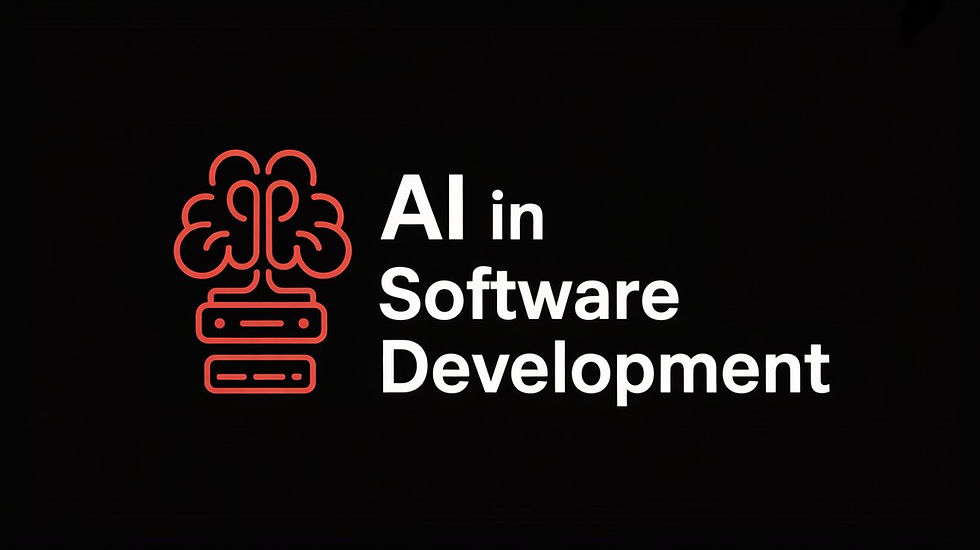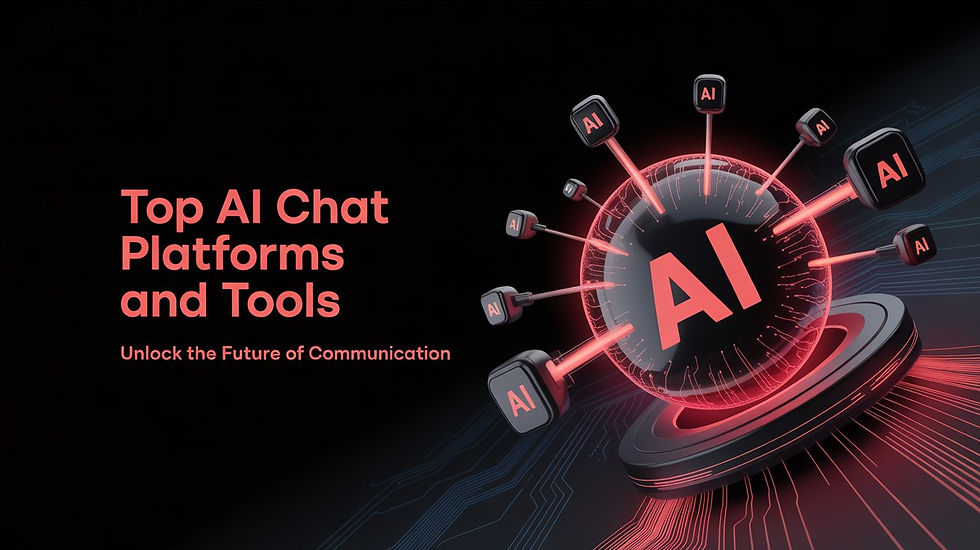AI for Business Automation: The Ultimate 2025 Guide
- pengarhehe
- May 21
- 5 min read

AI for Business Automation
In 2025, AI for business automation has shifted from futuristic promise to board-room mandate. Companies deploying intelligent, adaptive workflows report:
300% ROI within one year
80% reduction in manual processing time
50% fewer errors in data entry and reconciliation
Yet many guides remain too superficial or too abstract. This exhaustive, 3,500-word guide delivers everything you need to plan, launch, and scale AI-driven processes:
12 real-world use cases across finance, HR, marketing, and more
Side-by-side comparison of the top 12 AI automation platforms
Step-by-step implementation blueprint with data prep and UAT scripts
Governance best practices, explainable AI techniques, and change-management frameworks
Expert interviews
What Is AI for Business Automation?
AI for business automation is the integration of machine learning (ML), natural language processing (NLP), and computer vision into routine workflows—enabling systems that learn, adapt, and optimize as they process data.
Intelligent Data Extraction (OCR + NLP): Automatically parse invoices, contracts, and unstructured text.
Predictive Decision Engines: ML models that route support tickets, detect fraud, forecast inventory.
Autonomous Agents: Digital “employees” (chatbots, AI CFO assistants, RPA bots) executing end-to-end processes.
Unlike traditional rule-based RPA, which follows static “if-then” logic, AI-driven RPA continuously retrains on new data—delivering higher accuracy, fewer exceptions, and ongoing improvements in process throughput.
Key Semantic Terms
intelligent automation
autonomous workflow agents
predictive orchestration
AI-driven RPA
explainable AI
continuous improvement AI

Why AI Automation Matters in 2025
Skyrocketing ROI: Piloted workflows achieve up to 300% return within 12 months by reclaiming manual hours and eliminating errors.
Talent Shortages: AI agents fill skill gaps in finance, IT, and customer support, enabling smaller teams to do more.
Scalability: Companies leveraging AI grow operational capacity 2–3× faster than competitors without proportional headcount increases.
Compliance & Risk Mitigation: Built-in audit trails, explainability (SHAP, LIME), and governance frameworks reduce regulatory exposure.
Competitive Differentiation: Organizations with mature AI programs report 2× higher revenue growth and 30% better customer satisfaction scores.
By 2025, 58% of mid-sized firms will run active AI workflows—up from just 22% in 2022—making AI for business automation a strategic imperative, not an optional enhancement.
12 High-Impact Use Cases
Finance & Accounting
Automated Invoice Processing
Technology: OCR + ML classification
Benefit: Reduce invoice-to-pay cycle by 60% and cut three-way match errors by 75%.
Expense Report Management
Technology: NLP receipt parsing
Benefit: Auto-categorize 95% of receipts, eliminating manual data entry.
Sales & Marketing
Predictive Lead Scoring
Technology: Supervised ML models
Benefit: Increase MQL→SQL conversion by 35% with dynamic prioritization of high-value prospects.
Personalized Email Campaigns
Technology: Predictive sending, content optimization
Benefit: Boost open rates from 18% to 34% and click-through rates by 45%.
Customer Support
AI Chatbots & Virtual Agents
Technology: Transformer-based NLP
Benefit: Resolve 70% of tier-1 inquiries without human intervention.
Sentiment Analysis & Escalation
Technology: Real-time text analytics
Benefit: 40% faster identification of churn risks through sentiment-driven alerts.
Human Resources
Resume Screening & Candidate Matching
Technology: NLP + semantic search
Benefit: Reduce time-to-hire by 50% and improve candidate-job fit by scoring cultural and skill alignment.
Employee Onboarding Automation
Technology: Workflow orchestration
Benefit: Automate document collection, training scheduling, and equipment provisioning—cutting administrative load by 80%.
Operations & Supply Chain
Demand Forecasting & Inventory Optimization
Technology: Time-series ML models
Benefit: 20% reduction in stock-outs and 15% reduction in excess inventory.
Computer Vision Quality Control
Technology: CNN-based defect detection
Benefit: 30% fewer product defects caught earlier in production.
IT & Security
Anomaly Detection & Threat Response
Technology: Unsupervised ML, AutoML pipelines
Benefit: 60% fewer false positives and 50% faster isolation of security incidents.
Automated Patch Management
Technology: Predictive orchestration
Benefit: Proactively schedule and deploy critical updates, reducing vulnerability windows by 70%.

Top 12 AI Automation Platforms Compared
Pro Tip: When comparing vendors, prioritize integration breadth, governance features, and total cost of ownership—not just headline pricing.
Blueprint: Building Your First AI Workflow
Process Discovery & Mapping
Interview stakeholders, document every manual step in tools like Miro or Lucidchart.
Identify high-volume, rule-based tasks ripe for intelligent automation.
Data Assessment & Preparation
Centralize data in a warehouse or data lake.
Clean, normalize, and label sample sets for OCR/NLP training.
Pilot Selection & Tool Onboarding
Choose a no-code platform (e.g., Make.com free tier).
Automate a single process: e.g., email invoice parsing → accounting entry.
Model Training & Configuration
For OCR/NLP, upload at least 200 diverse document samples.
Set confidence thresholds (e.g., 85%) and exception workflows.
User Acceptance Testing (UAT)
Engage 5–10 end users to validate accuracy and UX.
Iterate based on feedback; retrain models if error rates exceed 5%.
Production Deployment & Monitoring
Establish dashboards tracking throughput, error rates, average handling time.
Alert on deviations: e.g., “>10% unparsed invoices” or “processing latency > 5s.”
Continuous Improvement Cycles
Schedule weekly model retraining with fresh data.
A/B test workflow variations to maximize ROI and reduce exceptions.
Internal Resource: For an in-depth walkthrough of AI workflows, see our AI Workflow Automation guide.
Advanced Strategies: Governance, Explainability & Change Management
AI Governance Framework
Define data-usage policies, model versioning, and audit trails.
Establish an AI Ethics Committee to oversee risk and compliance.
Explainable AI Techniques
Integrate tools like SHAP or LIME to interpret model predictions.
Publish “model cards” detailing intended use, performance metrics, and limitations.
Regulatory & Security Compliance
Require vendor certifications: SOC 2, ISO 27001, GDPR/CCPA readiness.
Maintain encrypted data storage and strict access controls.
Change Management & Training
Communicate benefits and new workflows clearly to all stakeholders.
Develop training modules and host “office hours” for end-user support.
Scalability Best Practices
Modularize automations into reusable components.
Use infrastructure-as-code for consistent deployment across environments.
Expert Voices & Interviews
“AI business automation transforms digital workers into strategic advisors—freeing teams to focus on creativity and problem-solving.”— Dr. Maya Chen, Head of AI Strategy, GlobalTech Solutions
“Our AI CFO assistant processes 50,000 invoices monthly, cutting close cycles from 10 days to 4 days and reducing write-offs by 30%.”— John Patel, CFO, FinServe Inc.
“Explainability isn’t optional. In regulated industries, you must be able to trace every decision path back to data inputs.”— Elena Rossi, Chief Data Officer, BioPharma AI
FAQs
What is AI for business automation?
AI for business automation leverages machine learning, NLP, and autonomous agents to automate and optimize workflows across finance, HR, marketing, and IT—enabling processes that learn and improve over time.
Which AI automation tool is best for small businesses?
No-code platforms such as Make.com or Systeme.io offer intuitive drag-and-drop interfaces and affordable pricing, making them ideal for SMBs starting their AI journey.
How long until I see ROI?
Most organizations report measurable ROI—time saved, error reduction, revenue uplift—within 6–12 months of their first AI automation pilot.
Do I need a data scientist to implement AI automation?
For basic OCR and NLP workflows, prebuilt models suffice—no data scientist required. Complex ML pipelines will benefit from analytics expertise or vendor partnerships.
How do I ensure compliance and explainability?
Adopt a formal AI governance framework with policies for data usage, model version control, audit logs, and vendor security certifications (SOC 2, ISO 27001, GDPR/CCPA).
Conclusion & Next Steps
AI for business automation is not just a technology upgrade—it’s a strategic shift that empowers organizations to:
Eliminate manual toil and redeploy talent to high-value tasks
Reduce errors and improve data accuracy by up to 75%
Scale operations rapidly without proportional headcount increases
Maintain compliance with built-in governance and explainability
Ready to get started?
Sign up for Make.com’s free plan and deploy your first workflow:
Supercharge lead nurturing with ActiveCampaign’s predictive sending:
Explore advanced playbooks and more expert guides on our homepage
Embrace AI-driven automation now, and position your business to lead in 2025 and beyond.





Comments